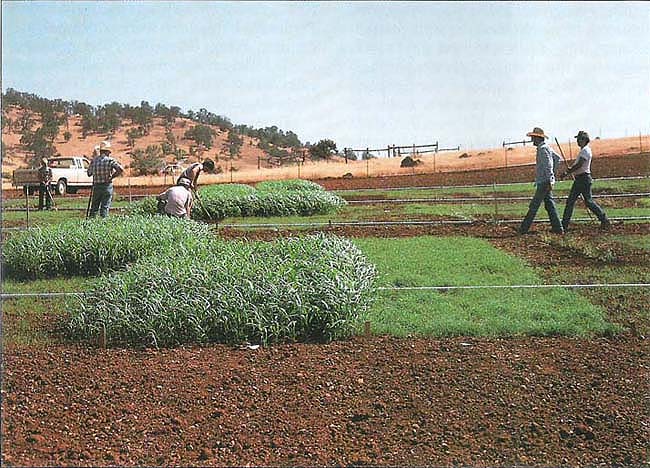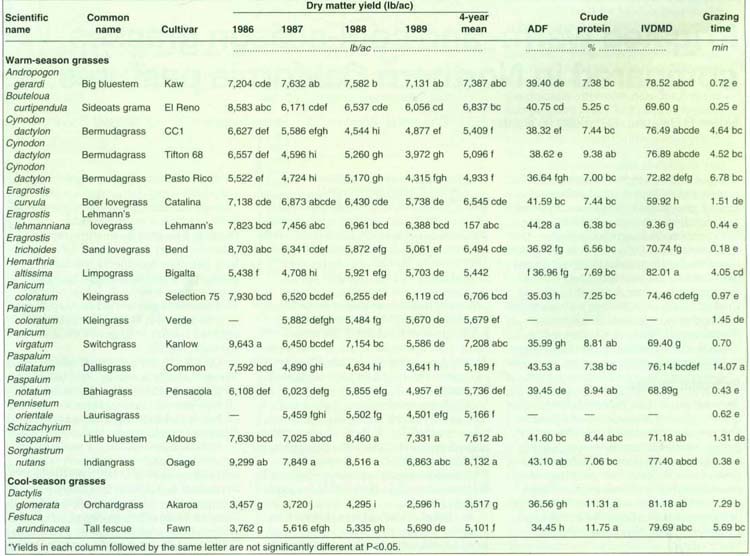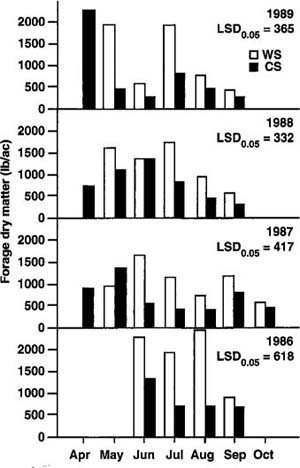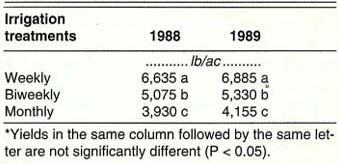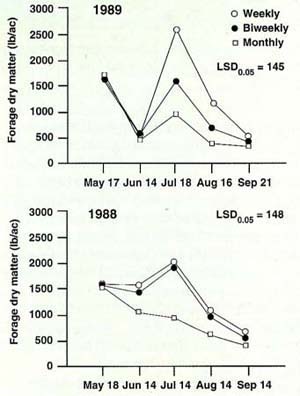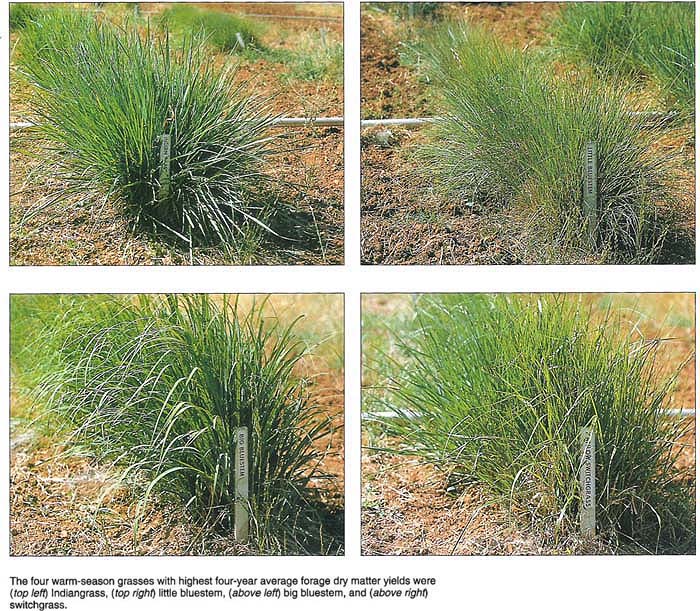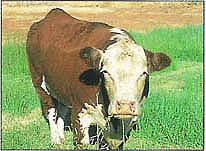All Issues
Irrigated warm- and cool-season grasses compared in Northern California pastures
Publication Information
California Agriculture 46(4):21-25.
Published July 01, 1992
PDF | Citation | Permissions
Abstract
North American prairie grasses were most productive in a comparative study of irrigated warm-and cool-season grasses. The high yield and later peak in production of warm-season grasses make them ideal for increasing the productivity of irrigated pastures in California. All grasses in the study survived reduced irrigation. Grazing cattle preferred dallisgrass over all other grasses.
Full text
Being of tropical origin, warm-season grasses have a higher optimum temperature for growth than do cool-season grasses, and therefore remain productive during hot summers. Sudangrass (Sorghum sudanense), corn (Zea mays), bermudagrass (Cynodon dactylon), and dallisgrass (Paspalum dilatatum) are common warm-season grasses produced for forage in California. Cool-season grasses include such common irrigated pasture grasses as tall fescue (Festuca arundinacea), orchardgrass (Dactylis glomerata), and perennial ryegrass (Lolium perenne).
Seasonal studies
Seasonal production potential, forage quality, grazing preferences, and production response to reduced irrigation are reported here for 17 warm-season grasses and 2 cool-season grasses. These studies were conducted over four growing seasons on a mixture of Auburn, Las Posas, and Argonaut loam soils at the University of California Sierra Foothill Research and Extension Center 17 miles northeast of Marysville.
Tillage and weed control were conducted from summer 1984 through spring 1985. On June 10, 1985, treble superphosphate (0-40-0) was applied at the rate of 400 pounds per acre (lb/ac). Irrigation water delivery was delayed until late July, 1985. On July 25, 1985, 14 entries were seeded (table 1). On August 13 of that year, sprigs of the limpograss and two bermudagrass entries were transplanted. On May 20, 1986, Verde kleingrass and laurisagrass were added to the experiment. The experimental design was a randomized complete block with 6-foot by 10-foot plots. The 19 entries were replicated six times.
All plots were fertilized April 1 and June 20, 1986, with 150 lb/ac of ammonium nitrate (35-0-0). In 1987, ammonium phosphate sulfate (16-20-0) was applied at 375 lb/ac on May 20 and August 20. In 1988, the same fertilizer was applied at 625 lb/ac on May 15. In 1989, 230 lb/ac were applied June 15.
In 1986 and 1987, all replications were irrigated weekly, beginning April 20 and April 13, respectively. The amount of water that evaporated from a nearby Class A evaporation pan during the previous week was applied during weekly irrigations. In 1988 and 1989, weekly, biweekly, and monthly irrigation treatments were applied to two replications each (see sidebar). Irrigation treatments applied an amount of water equal to the previous week's pan evaporation. Irrigation treatments were begun in 1988 on May 20 and in 1989 on May 2. In 1988, all replications received weekly irrigations from April 12 through May 20.
On May 20, 1986, the plots were mowed to control weeds. Yield measurements began on June 10, 1986. A 3-foot by 10-foot area was mowed from the center of each plot. A 4-inch-high stubble remained following monthly harvests.
In 1986, harvested forage was sub-sampled and analyzed for crude protein, acid detergent fiber (ADF), and in-vitro dry matter digestibility (IVDMD). Acid detergent fiber is a measure of the cellulose and lignin concentration of forage. As ADF increases, total digestible nutrients (TDN) usually decrease. In-vitro dry matter digestibility is a laboratory method of estimating digestibility. It is a measure of the amount of dry matter digested by rumen microbes in 48 hours.
To estimate relative preference for each entry, grazing time in each plot was determined on the morning after the June, July, August, and September harvests in 1987 and 1988 (see sidebar). Three heifers were allowed to graze the remaining forage in each 6- by 10-foot plot following the harvest of a 3- by 10-foot strip. The heifers were fasted overnight and allowed to graze for 2 hours. During that period an observer assigned to each heifer recorded the amount of time spent actively grazing (grazing and chewing) in each plot. Grazing time began with the first bite and continued until the animal left the plot or ceased active grazing.
Forage dry weight, crude protein, ADF, IVDMD, and grazing time were subjected to analysis of variance, and treatment means were separated using Duncan's multiple range test at the 5% level of probability. A growth index (percentage of total annual yield produced per day) was regressed on the average daily temperature (mean of the daily high and low temperatures) for each harvest period to estimate optimum temperature for growth. Quadratic equations describing the regression of the growth index on average daily temperature were determined for warm-season and cool-season species.
Forage yield
Grasses native to the North American prairie (Osage Indiangrass, Aldous little bluestem, Kaw big bluestem, Kanlow switchgrass) and Lehmann's lovegrass were the most productive entries over the 4-year period of the trial (table 1) and were not significantly different (P < 0.05). Orchardgrass yield for the 4 years was significantly lower (P < 0.05) than that of all other entries. The bermudagrasses, limpo-grass, tall fescue, laurisagrass, common dallisgrass, Verde kleingrass, and Pensacola bahiagrass were not significantly different (P < 0.05). Their yields exceeded that of orchardgrass, but were significantly less (P < 0.05) than that of the highest-producing entries.
The warm-season grass yields exceeded the yields of the cool-season species in most months from May through September (fig. 1). May 1987 and June 1988 were exceptions, but cool-season yields were not significantly higher on those dates. In each year of the study, the warm-season grasses reached their peak yields after the cool-season grasses. The cool-season species had peak yields in April, May, or June; the warm-season species produced their highest yields in June, July, or August. The warm-season grasses were dormant during winter; the cool-season grasses remained green all year. Although late fall through early spring production by the cool-season species was low, there was sufficient forage to harvest in April before the onset of growth by the warm-season species.
TABLE 1. Annual forage dry matter yield for 4 years; ADF, crude protein, and IVDMD for 1986; and grazing time for 1987 and 1988 for 17 warm-season and 2 cool-season grasses at the Sierra Foothill Research and Extension Center*
Forage yield on June 14, 1989, was low because the period between the May 17 harvest and this date was unusually cool. The average daily maximum temperature for the period from May 9 to June 11 was 79°F, 6° below normal. Twelve days during the period had maximum temperatures that were more than 10° below normal.
The optimum average daily temperatures for growth of the cool-season and warm-season entries were 70° and 79°F, respectively. Cool-season grasses such as orchardgrass and tall fescue are most productive when temperatures are cooler. Cool-season grasses remain green all year but produce poorly in high summer temperatures. Warm-season grasses such as switchgrass, bluestems, bermudagrass, crabgrass, johnsongrass, and corn begin to grow in late spring, and do most of their growing during the warmest months of the year.
Forage quality
One criticism of warm-season grasses has been their apparently low forage quality. Many studies show that their crude protein levels rarely exceed 16%, and may be as low as 3%; most reports range from 6 to 10% crude protein. In this study, the cool-season grasses were highest in crude protein, but not significantly higher than little bluestem, Pensacola bahiagrass, switch-grass, and Tifton 68 bermudagrass (table 1).
Lehmann's lovegrass and dallisgrass were highest in ADF, but not significantly different from Indiangrass. Tall fescue was lowest in ADF. Limpograss had the highest IVDMD, but not significantly higher than big bluestem, Indiangrass, orchard-grass, and tall fescue. Boer lovegrass had the lowest IVDMD.
Forage management
Studies of the five highest-producing entries in other states show that forage quality remains high if high leaf-to-stem ratios can be maintained. Rotational grazing and short stubble heights encourage leaf production that will result in high-quality grazing. Rotational grazing with rest periods of 4 weeks or more is considered essential if cattle reduce stubble to less than 6 inches and consume nearly all leaves. If the stubble height is maintained at 10 to 16 inches, continuous grazing is allowed.
Fig. 1. Monthly forage dry matter yields of warm-season (white bar) and cool-season (dark bar) grasses, 1986-1989.
Grasses survive reduced irrigation
Total yield during 1988 and 1989 was significantly higher (P < 0.05) for the weekly irrigation treatment than for the biweekly and monthly treatments (table 2). Yield of the biweekly irrigation treatment was significantly greater (P < 0.05) than the monthly treatment.
In 1988, monthly yield estimates for the weekly and biweekly irrigation treatments were not significantly different (P < 0.05) (fig. 2). The yield of the monthly irrigation treatment was significantly reduced (P < 0.05) from the more frequent irrigation treatments, except for the May harvest, which was 2 days before initiation of irrigation treatments. In 1989, there was no difference in the May yields, which were harvested 2 weeks after initiation of irrigation treatments. There were only slight differences in yields between treatments on June 14. In July and August, yields for each treatment were significantly different (P < 0.05). In September, monthly and weekly treatments were significantly different (P < 0.05), but they did not differ from the biweekly treatment.
TABLE 2. Total annual forage yield (Ib/ac) for weekly, biweekly, and monthly irrigation treatments, UC Sierra Foothill Research and Extension Center*
In 1988, scattered rain through June probably reduced evapotranspiration and helped to maintain enough soil moisture to allow the weekly and biweekly irrigation treatments to produce similar yields; the monthly irrigation treatment gave insufficient supplementation of natural rainfall and soil moisture to maintain forage yield. In 1989, May and June were cooler than normal and characterized by daily traces of precipitation that reduced evaporation and suppressed forage production. Warmer temperatures starting in mid-June increased evapotranspiration and subsequent soil moisture depletion sufficiently to reduce forage production in the bimonthly and monthly irrigation treatments during July and August.
Poor spring rainfall, late spring irrigation water availability, and water rationing during drought combine to make soil moisture availability for irrigated pasture undependable in northern California. While most of the warm-season grasses in this study were more productive than the cool-season grasses, they did not demonstrate any special advantage over the cool-season species under reduced irrigation. Similar forage yields May 17, 1989, following the first year of irrigation treatments suggest that the yield capacity of plots subjected to reduced irrigation was not permanently damaged.
The four warm-season grasses with highest four-year average forage dry matter yields were (top left) Indiangrass, (top right) little bluestem, (above left) big bluestem, and (above right) switchgrass.
Tall fescue and orchardgrass are commonly found in Northern California irrigated pastures. While they performed poorly in this study, they will produce winter and early spring forage, especially if they are fertilized in fall. A mixture of cool- and warm-season grasses should provide the benefits of each. The cool-season species are most productive when moisture is abundant and temperatures are cool in spring and fall. Warm-season grasses are most productive when warm-summer temperatures prevail.
Of the five highest-producing entries, Lehmann's lovegrass was lowest in IVDMD, but not significantly lower than switchgrass and little bluestem. Lehmann's lovegrass was highest in ADF. Lehmann's lovegrass also tended to spread via seed into areas where it was not wanted, so we do not recommend its use.
Conclusion
Warm-season grasses have the potential to increase irrigated pasture yields later in summer than the cool-season grasses that have been traditionally used. Warm-season grasses were more productive than cool-season grasses and they remained productive later in the summer. By extending peak pasture productivity and increasing total yield, warm-season grasses have the potential to increase irrigated pasture production, carrying capacity, and productivity per acre. Increasing productivity without increasing fertilizer or irrigation inputs will increase fertilizer and water use efficiency. Reduced irrigation during water rationing should not have long-lasting affects on the forage yield of warm- or cool-season species.
Warm-season grasses usually are lower in quality than cool-season grasses. To maintain higher forage quality and to gain the early production benefits of cool-season species, a mixture of warm-season grasses and cool-season grasses and legumes would be preferable. This condition exists in many valley and foothill pastures where dallisgrass, a warm-season species, is present.
Continued research should be conducted on forage quality, animal performance, livestock-forage systems, and competitive relationships among warm-season grasses, cool-season grasses, and legumes. There is no reason, however, why interested producers should not test Indian-grass, switchgrass, big bluestem, and little bluestem on a small scale to determine their utility in individual operations. The lead author can provide a list of midwestern seed sources.
Grazing heifers prefer dallisgrass
Grazing heifers spent more time grazing dallisgrass than any other entry (table 1). Each heifer averaged more than 14 minutes grazing dallisgrass during each of eight 2-hour grazing periods during two growing seasons. Orchardgrass, tall fescue, and the three bermudagrass entries were grazed an average of 4.5 to 7.3 minutes during each of eight grazing periods.
The five highest-producing entries received little use. Grazing livestock often prefer forage with which they are familiar, and dallisgrass, orchardgrass, and tall fescue are the dominant grasses in irrigated pastures at the Field Station. Bermudagrass is present in some pastures.
Management practices can be developed based on research in other states. Irrigation scheduling and fertilizer practices would be similar to those for existing cool-season pastures. Rotational grazing of warm-season grasses is crucial to managing warm-season forage quality. In a rotational grazing system, a postgrazing stubble height of about 6 inches should increase pasture leafiness. Under continuous grazing, stubble heights of 10 to 16 inches should be the target. Because these species are extremely robust and competitive, they may gradually exclude existing cool-season species if seeded into an existing pasture.



